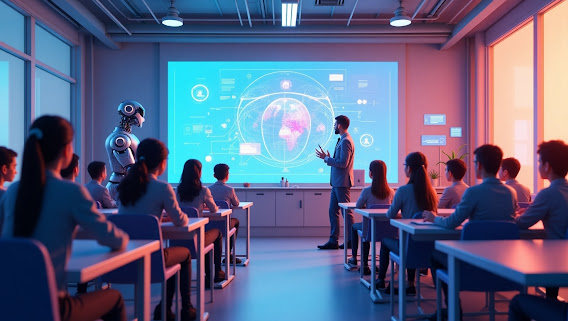AI in Education 2025: How Schools Are Using Bots to Teach Smarter?
AI in Education 2025: How Schools Are Using Bots to Teach Smarter
Artificial Intelligence is no longer a futuristic concept—it’s here, and it’s reshaping how students learn and how teachers teach. As we step into 2025, schools worldwide are embracing AI-powered bots to streamline operations, enhance student engagement, and personalize the learning experience. From grading papers in minutes to offering one-on-one tutoring through chatbots, AI is not replacing educators—it’s empowering them.
The education landscape is changing rapidly, driven by a need for smarter solutions. With student-teacher ratios on the rise, administrative burdens piling up, and learning gaps widening post-pandemic, AI bots have emerged as indispensable allies. They're not just making classrooms more efficient—they’re making them more human by freeing teachers to focus on what truly matters: mentoring and inspiring young minds.
In this article, we explore the cutting-edge ways AI bots are revolutionizing education in 2025, backed by data, expert insights, and practical examples. Whether you're a teacher, parent, or school administrator, this comprehensive guide will help you understand and navigate the AI-powered future of education.
1. Personalized Learning Paths with AI Bots
AI bots analyze student performance data in real-time and customize lessons to fit each learner’s pace and style. Platforms like Squirrel AI and Century Tech use adaptive algorithms to tailor learning materials based on cognitive strengths and weaknesses.
Bots track metrics such as response time, accuracy, and engagement.
Real-time feedback encourages student motivation.
Reduces over-reliance on standardized testing.
Stat: According to McKinsey (2024), adaptive learning tools can improve student outcomes by up to 40%.
Expert Quote: "AI is enabling a shift from teaching to learning. Students are no longer passive recipients—they’re active participants in a personalized journey." – Dr. Priya Menon, EdTech Researcher
2. AI-Powered Teaching Assistants: Saving Teachers 10+ Hours Weekly
AI bots are becoming virtual teaching assistants, handling routine tasks such as grading, answering common student questions, and scheduling. Google’s Classroom Assistant and Microsoft’s AI Copilot are two popular examples.
Automates grading and feedback for quizzes, assignments
Handles FAQs in chat-based interfaces
Assists with lesson planning by suggesting content
Stat: A 2024 UNESCO report showed that AI TAs reduce teacher administrative workload by 30%.
Expert Insight: “Teachers are seeing AI not as a threat but as a helping hand. The saved time is reinvested into one-on-one student mentoring.” – Ravi Kumar, Educational Consultant
3. AI-Driven Assessment and Progress Tracking
Assessment is no longer a stressful, end-of-term ritual. AI bots continuously track student performance and deliver insights to teachers and parents.
Dynamic quizzes and formative assessments
Predictive analytics to identify learning gaps early
Personalized report cards and dashboards
Stat: Research from Stanford (2024) found that predictive AI assessments identify at-risk students 3x faster than traditional methods.
4. Emotional AI: Supporting Student Mental Health
AI bots equipped with sentiment analysis and voice recognition help monitor student mood, stress levels, and engagement.
AI chatbots act as first responders for emotional support
Can escalate concerns to counselors
Helps identify patterns of disengagement or distress
Stat: Emotional AI has helped reduce student absenteeism by 22%, according to a 2025 EdTech Insight study.
5. The Ethics of AI in Classrooms: Privacy, Bias & Oversight
With great power comes great responsibility. AI in education raises ethical concerns around data collection, algorithmic bias, and student privacy.
Transparent AI policies are crucial
Schools must involve parents and educators in AI selection
Regular audits and human oversight are non-negotiable
Stat: 68% of parents surveyed by EdWeek (2024) expressed concern over student data usage by AI tools.
Expert Quote: “Responsible AI is not just a choice—it’s a duty. Educators must demand transparency from AI providers.” – Sunita Rao, Digital Ethics Advisor
Conclusion: The Human-AI Collaboration is the Future of Learning
AI bots are not here to replace teachers—they are here to support them. The schools that embrace AI as a tool—not a takeover—are the ones seeing the most benefit. By automating repetitive tasks, personalizing learning, and tracking student progress more efficiently, AI is reshaping education to be smarter, faster, and more empathetic.
If you're an educator, policymaker, or parent, it’s time to get involved. The classroom of the future isn’t coming—it’s already here.
Share this post on social media and tag a teacher or school that’s ready to embrace smarter learning.
FAQs: Long-Tail Keyword Section
What are AI bots in education?
AI bots are software tools powered by artificial intelligence that help with teaching, grading, student support, and personalized learning.
Are AI bots replacing teachers in 2025?
No. AI bots assist teachers by reducing workload and providing smart insights. They are support tools, not replacements.
Is AI in education safe for students?
Yes—when implemented with proper data policies, oversight, and transparency.
How can schools start using AI bots?
Start with simple AI grading tools or virtual assistants. Ensure staff are trained and parents are informed.
Which are the best AI bots for schools in 2025?
Top names include Century Tech, Squirrel AI, Google’s Classroom Assistant, and Khanmigo from Khan Academy.


.jpg)






Comments
Post a Comment
Your feedback is appreciated. Share your comments below!
Be respectful and kind while commenting. Thanks for participating!